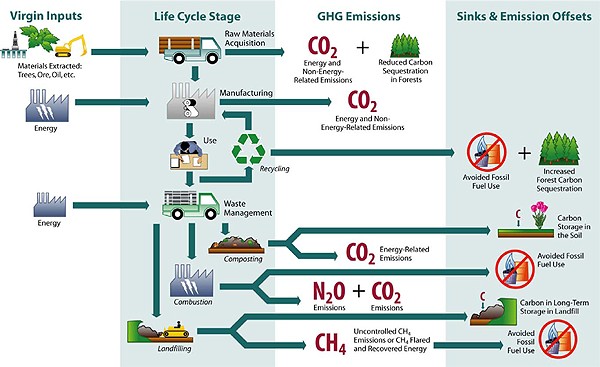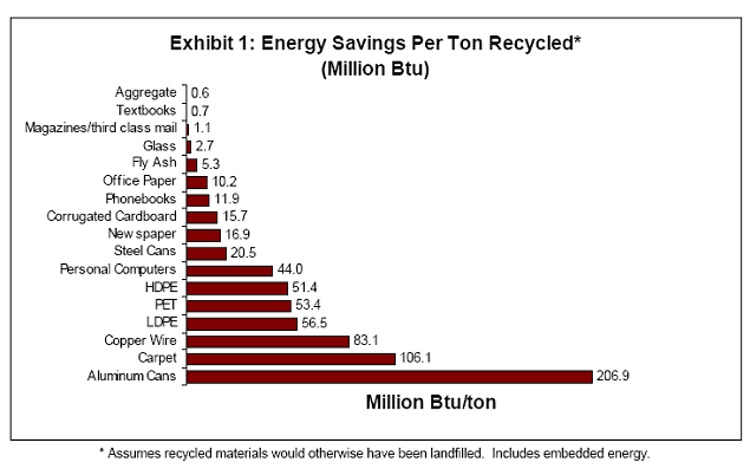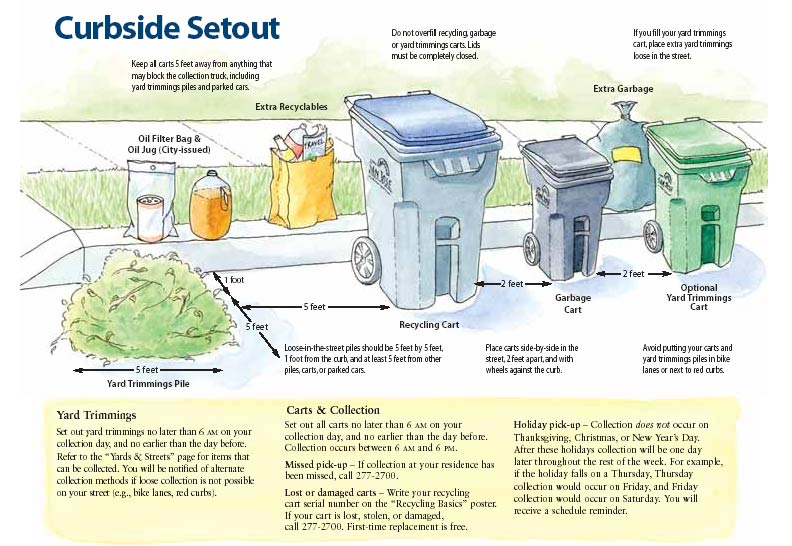Long Term Initiative
|
Municipal Solid Waste Management |
CASE STUDY:
Rapid City, SD |
With the realization that their landfills were quickly filling Rapid City, South Dakota, initiated an aggressive composting and recycling programs. A Solid Waste Plan was first passed by the City Council in 1992, but it was not until 2003 that the plan became fully operational.[23] According to Barbara Petroff, project manager for USFilter's IPS Composting System, which was used in the facility, these efforts will extend the life of the landfill by 30 years and enable the city to avoid the purchase of over 1,000 additional acres.
The system composts wastewater biosolids, food, paper, yard waste and other organic residuals and is designed to convert 213 tons of waste into compost per day. A chemical scrubber and biofilter treat the processed air generated at the composting building to remove odors. The city sells the compost for use in golf courses, nursery potting soil, reclaiming land and other applications, for about $20-30 yard. These sales help pay for operating the compost facility, which uses no tax dollars to maintain operations.[24]
CONTACT
Jerry WrightPublic Works DepartmentRapid City, SD(605) 355-3496[email protected]
Barbara PetroffU.S. Filter IPS Composting System(508) 347-7344www.usfilter.com |
Municipal Solid Waste Management |
CASE STUDY: Northwest Indiana |
In 2004, the Northwest Indiana Solid Waste District Board[25] began offering education grants for schools in the six-county district. The funds are available for schools to support waste reduction education and recycling. $30,000 is appropriated each year with each county receiving up to $5,000. This augments funding the district has had available for cities and towns since 1997.
Each year, the District Board allocates $120,000 for the Cities and Towns Grant Program to implement or expand waste management programs that coincide with the District's objectives for waste reduction.[26] The purpose of the grant is to support integrated waste management programs around source reduction, recycling, composting and education. $20,000 is allotted for division among the successful applicants from each county. Cities and towns must match grants given by the board by 25%; however, education grants given to schools do not have a matching requirement.
The Board is involved in outreach and education projects throughout the district. Funding for the Board and for grants comes from landfill tipping fees collected in the district. The District encourages creativity and unique planning for projects. A short list of some suggestions is provided here:
CONTACT
DirectorCarol StradlingNorthwest Indiana Solid Waste(574) 583-5976[email protected] |
Municipal Solid Waste Management |
CASE STUDY: Palo Alto, CA |
The city of Palo Alto, California adopted a Zero Waste Resolution in 2005. The goal is to divert 73% of their waste by 2011 and 100% by 2021.[27] The Council also adopted the Zero Waste Strategic Plan as guidance for city staff to achieve the goals.[28]
In 2003, the total tons generated were 166,548. The current city diversion rate of 57% equals about 95,000 tons per year. To achieve its goals for 73% diversion by 2011 as part of a Zero Waste Strategic Plan, the city needs to divert an additional 26,000 tons per year of materials.
Current processing, transfer and disposal costs are about $82.50/ton. On that basis, the avoided costs of processing, transfer and disposal for this additional 26,000 tons would be approximately $2.1 million/year.
Based on assumptions detailed in its strategic management plan, the city estimates that diverting this amount will result in an overall savings of over $800,000 per year.
The Strategic Management Plan suggests city programs, policies, rates, and financial and contractual commitments should be adjusted to help achieve the Zero Waste goal as follows:
CONTACT
Russell ReisererSolid Waste Manager(650) 496-5910[email protected] |
Municipal Solid Waste Management |
CASE STUDY: San Jose, CA |
San Jose has been one of the leaders in creating incentives for reducing waste by implementing “pay as you throw”[29] policies. Citizens are charged to dispose of garbage and the rate is based on the size of garbage carts. Recycling is unlimited at no charge.
As San Jose website states “By recycling as much as you can, you will be able to use the smaller garbage cart sizes, which cost less.”[30]
San Jose is one of the few cities that recycles more than 64% of their solid waste. Since the curbside recycling started the city has recycled:
|
Tools for Community Waste Prevention
The community waste prevention toolkit was created by INFORM to help a city walk through eight key questions: [32]
Who is responsible for waste disposal, recycling, and waste prevention in your area?
Which political subdivision (e.g., the city, town, county, etc.) is responsible for solid waste prevention, recycling, and disposal policies and programs? What role does the state play in solid waste regulation, funding, etc?
Which specific agency or office is responsible for overseeing solid waste prevention, recycling, and disposal? Who heads it? To whom does this agency report on its operation? Are any other governing bodies involved in an oversight or funding capacity?
Who is the community (and state) waste prevention program manager? If there is no such position, who is the recycling coordinator? Is promoting waste prevention officially part of his or her job responsibility? Does the community have any additional staff devoted to waste prevention programs and policy development? What are their responsibilities?
What is the size of the waste challenge?
How much waste does the community/state generate each year, either by weight (tonnage) or volume (cubic yards)? Are waste generation rates increasing, as they are nationally? Where is this information published? How much waste did the community/state generate in the most recent year? What is the trend in generation over the last five years? Absolute waste and waste per capita? What is projected for the next five? Absolute and per capita?
What goals have been set for waste generation, disposal, recycling, and waste prevention?
Do specific goals for waste prevention exist? Are they distinct from goals for recycling? How do the goals compare to other state or municipal goals? Have the recycling and waste prevention goals been met? How much waste prevention is projected over the next five years?
How does the community handle its waste?
Is it collected by the municipality or by private carters? Is waste generated by residents, institutions and businesses handled differently? How much waste goes to landfill, to incineration, and to recycling? What are the landfill, incineration and recycling trends over the last five years? What is projected for the next five years?
What waste prevention strategies are being used?
Does the community operate or fund any materials reuse programs, such as drop-off sites, a telephone hotline or a web site facilitating donations and/or exchanges of furniture, appliances, office equipment, art supplies and other items that can be reused?
Has the community or state banned curbside collection or disposal of certain items such as tires, batteries, yard waste, appliances and computer monitors in order to promote reuse and recycling?
Does the community operate or fund on-site composting, "leave-it-on-the-lawn," or other waste prevention programs for grass, leaves, food scraps, and other types of organic materials? Does it help residents to set up their own backyard composting systems? Do any public offices or institutions compost their own waste?
Does the local government have a program to send surplus items to other public offices or institutions for reuse? Does it operate a surplus warehouse? How does the government agency in charge of the surplus program publicize the availability of reusable items to potential recipients? Is the warehouse easily accessible to government employees? Are available items listed on the Internet?
Do local schools and other public institutions with food service facilities use reusable dishes and/or cutlery? If not, do they have access to (and space for) dishwashing equipment? How much are they paying to buy and dispose of single-use items?
Are leftover paint, carpet, fixtures and other items from construction projects diverted to other community projects?
How does the community educate the public about waste prevention and recycling?
Are there any ad campaigns devoted specifically to waste prevention? Are any written materials provided to residents, businesses and public institutions? How are they disseminated?
What is the waste economic picture?
How much of the community's budget is used to pay for solid waste collection, processing, and disposal (tipping fees)? What is the budget for waste prevention (beyond what is available to promote recycling)? Is the waste prevention budget commensurate with the portion of waste it is expected to address? What is the cost per ton of the community's waste prevention, recycling and disposal programs?
Does the community provide residents, businesses, and/or public institutions with economic incentives to reduce their generation of waste? For example, do residents, businesses or public institutions pay for disposal based on the amount of waste they generate?
What laws and public policies promote waste prevention?
Has the local or state government adopted any goals or mandates for reducing the amount of waste generated (in addition to recycling goals and mandates)? What are the respective timeframes for reaching these goals or mandates? How does the community plan to measure whether waste reduction goals or mandates have been met?
Has the community or state passed any legislation promoting waste prevention, such as mandatory bottle deposits or requirements that product manufacturers collect electronics, batteries, carpeting or other items for reuse or recycling (considered to be "extended producer responsibility" requirements).
Has the locality enacted any executive orders or laws directing government agencies to practice waste prevention and/or environmentally preferable purchasing? Are public agencies encouraged to use products powered by alternatives to batteries or to use rechargeable batteries? Do public agencies use duplexing copiers and printers, remanufactured laser toner cartridges and other waste-reducing products? Who is in charge of the community's EPP program?
Does the local government encourage vendors to practice waste prevention? For example, have government contracts been written to give preference to or require vendors to ship their products in bulk or reusable containers?
Does the local government or state provide incentives for businesses to practice waste prevention? For example, does it provide financial support to businesses that want to acquire dishwashing equipment? Is technical support available to facilitate waste prevention among businesses? Does the community reward or publicize companies that encourage waste prevention (for example, by taking back hangers and packaging material for reuse)?
Additional Resources
List of Waste Management Resources
www.dnrec.delaware.gov/SWMTWG/Documents.htmEPA WasteWise Program
WasteWise is a free, voluntary, EPA program through which organizations eliminate costly municipal solid waste and select industrial wastes, benefiting their bottom line and the environment. WasteWise is a flexible program that allows partners to design their own waste reduction programs tailored to their needs. www.epa.gov/wastewise/EPA Waste Reduction Model (WARM)
EPA online calculator created to help solid waste planners and organizations track and voluntarily report greenhouse gas emissions reductions from several different waste management practices. yosemite.epa.gov/oar/globalwarming.nsf/content/ActionsWasteWARM.htmlU.S. Composting Council
The USCC is a trade and professional organization promoting compost. They are involved in research, public education, composting and compost standards, expansion of compost markets and the enlistment of public support. www.compostingcouncil.org/index.cfmGrassroots Recycling Network Zero waste Briefing Kit,
www.grrn.org/zerowaste/kit/briefing/index.htmlConversion facility, fermentation to methane
www.jgpress.com/archives/_free/000479.htmlGasification for Power Generation
www.alamedapt.com/newsroom/reports/finalgasification.htmlToronto Study on New Technologies—good brief descriptions
www.toronto.ca/wes/techservices/involved/swm/net/pdf/overview_net.pdfUC Davis Review of New Technology
biomass.ucdavis.edu/pages/reports/Conversion-PhaseI_IWM-C0172.pdfCity of Berkeley Resolution No. 62,849–N.S, Adopted March 22, 2005
Reaffirming the city’s zero waste goal and referring the issue to the solid waste commission.
www.ci.berkeley.ca.us/sustainable/government/62849.pdf






















